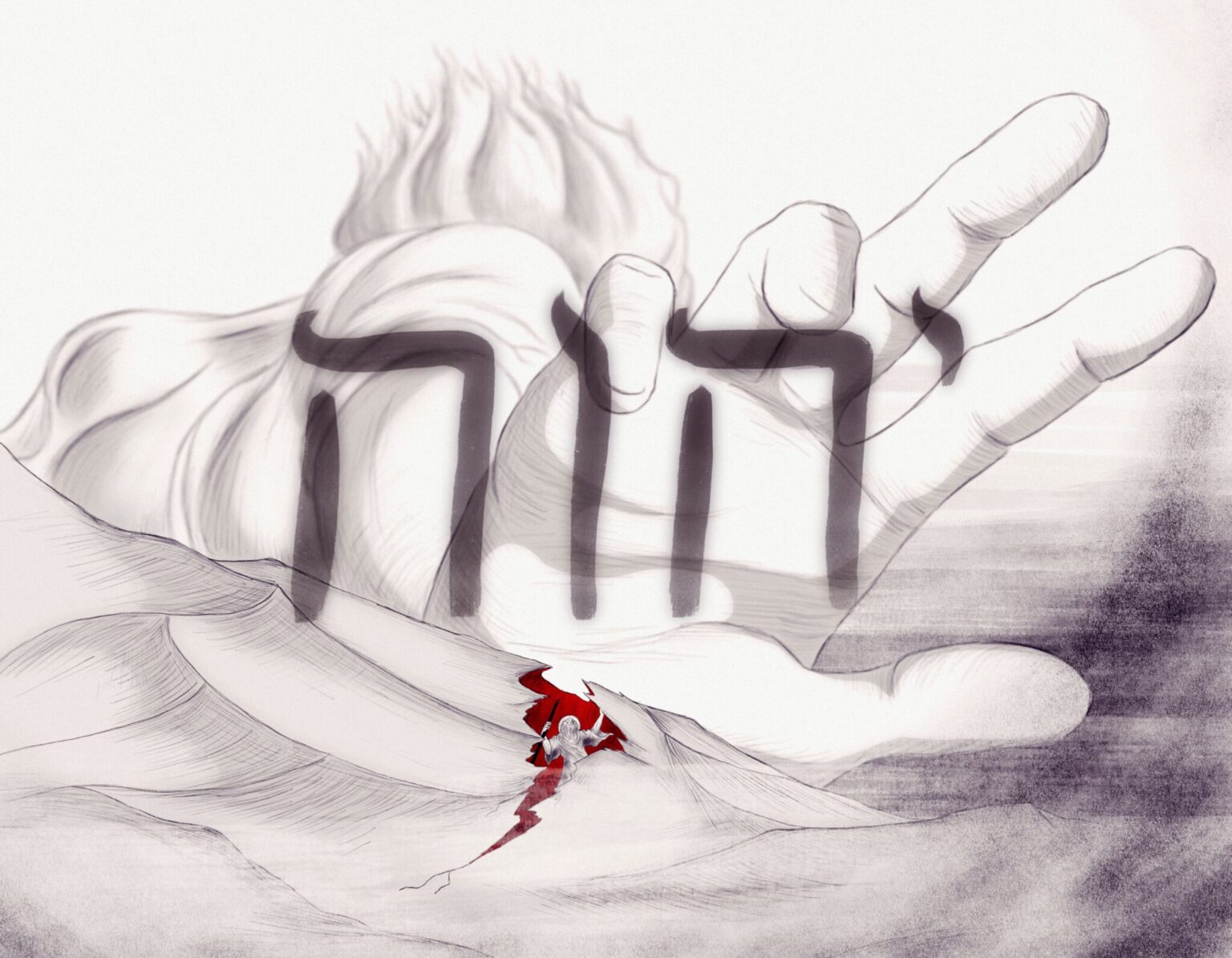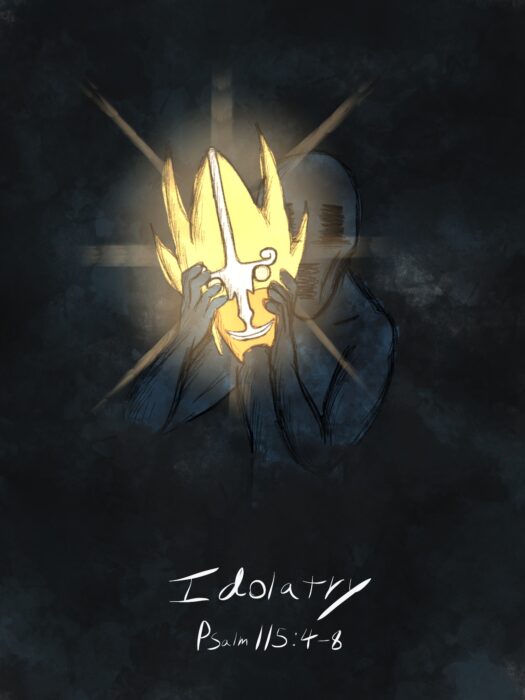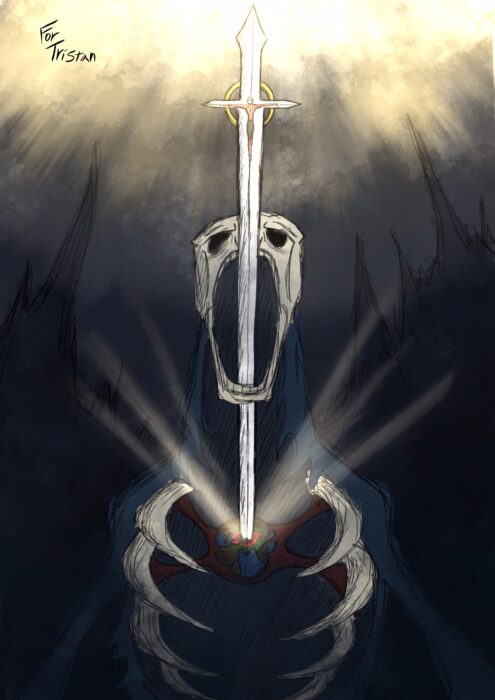Show Me Your Glory
In Exodus 33:18, Moses asks to see God’s glory and God responds by saying that He will tell Moses His Name. Now, in scripture, a name is much more than a way of referring to someone. Rather, a name is intended to express something essential about its owner, like a one-word summary of someone’s identity. So when God proclaims His name in the next chapter (34:6-7), He is actually unfolding His character to Moses (and to us), He is revealing His identity, He is showing His people Who He Is. And the staggering thing is that this is God’s response to the request to see His glory. What is the glory of God? According to Exodus 33-34 it is the proclamation of the Name of God, the exposition of His identity, His internal beauty communicated externally, it is God made known.
But while He proclaimed His identity to Moses, YHWH Himself would pass by, and the splendor of His presence would have destroyed Moses (Ex.20). So, in order that Moses might rejoice in rather than be destroyed by the glory of God, YHWH places Moses in “the cleft of the rock” and covers the prophet with His hand (22). Now, this is significant for at least four reasons.
Four Things To Note
First, God is often referred to in scripture as the Rock and Refuge of His people (Deut. 32:4,15,18; Ps.18:2, 57:1, 61:2-3, etc.). No words or scenarios in the Bible are wasted, and so we should not think it coincidental that Moses takes refuge in a rock. I don’t think we can read this account in light of the whole of scripture without recalling that God Himself is so often the Rock of our Refuge.
Second, it should be noted that a “cleft” in a rock is something like a fissure or crack or crevice. Moses is hidden in a rock that has been broken; it is a wounded rock. And more than that, he is hidden in the cleft of the rock. Here we see Moses taking refuge from the destroying presence of God in the wound of a rock…echoes of Calvary should start to fill our minds.
Third, there is at least some reason to believe that the rock in which Moses is hidden is actually the rock that was struck and from which life-giving water flowed in Exodus 17. Before I go on I should note that I am indebted to my fellow seminarian John Supica for most of the following insights.
In Exodus 17:6 we read that the rock which Moses struck was “at Horeb,” and Horeb is believed by many to be another name for Sinai. We know that when the rock was struck it split open so that water could gush from it like a river (Ps.105:41, Is.48:21), which means there must have been at least some sort of fissure torn into it. Could this not be the same cleft–the same “wound”–into which Moses is placed by God so that he might not perish? If this is the case then we are warranted to see Christological imagery in this scene for two reasons. First, Paul tells us that the rock split in the wilderness was a type of Christ (1 Cor.10:4). And secondly, the story of the striking of the rock in Exodus 17 is presented very intentionally as an acto of YHWH’s own substitionary self-giving (the full explanation of that scene is, however, for another post–perhaps by John Supica himself). Without a doubt Exodus 17 foreshadows the work of Christ on the cross; and–as I said–there is evidence to believe that the rock of Exodus 17 is the same one in whose wound Moses takes refuge in Exodus 33.
Fourth, notice that YHWH covers Moses with His hand. Of course, this is anthropomorphic language since before the incarnation of the Son in human history, God had no body. However, the use of “hand” imagery is not insignificant. Often times God’s “hand” is synonymous with His saving, preserving strength toward His people (Ex.15:6; Ps.17:7, 60:5, 63:8; Is.41:10). This imagery reaches its climax on the cross where the hand of YHWH incarnate, God the Son, is stretched out and lifted up in the supreme act of redemption. I don’t think that we can read a text about the hand of God working to save His own (or, in this case, cover them from destruction) without seeing–as Thomas–the hands of our Lord and our God–wounded to save His own.
God places Moses in the wound of a life-giving rock and covers him with His hand
so that the prophet might enjoy God’s glory and not be destroyed by it. God’s preparation to declare His glory to Moses abounds with Christological imagery. And we ought to keep this in mind as we turn to chapter 34 and see YHWH deliver the definitive Old Testament proclamation of His identity–His Name–to Moses.
The Name Declared On Sinai
“YHWH, YHWH, a God gracious and merciful, slow to anger and abounding in steadfast love and faithfulness, keeping steadfast love for thousands, forgiving iniquity, transgression and sin, but who will by no means clear the guilty…”
– Exodus 34:6-7
The Name of God proclaimed in Exodus 34:6-7 is paradigmatic for how God’s people perceive Him throughout the rest of scripture. While much–indeed, infinite–could be said about it, in this post I simply want to note the central character description: “…abounding in steadfast love and faithfulness.”
As the history of God’s revelatory redemption continues, these two words seem to form a sort of “short hand” reference back to God’s identity-revelation on Sinai. They often appear in contexts where God’s covenant keeping grace is sought or displayed, and tend to be expressive of the forgiving, merciful, inexorable love of God for His covenant people (Ps.40:11, 57:1-3, 69:13-14, 85:4-10, 89:23-26 > variant word used for faithfulness<,108:3-5, 115:1; Hos.4:1). No one who casts themselves wholly on the Name of God as revealed on Sinai will be put to shame…
However, there is a tension present when a sinner appeals for mercy from a God whose Name is “abounding in steadfast love and faithfulness.” Though He is full of unfailing and forgiving love, His faithfulness to His covenant would seem to demand the destruction of those who oppose Him. This tension at the heart of YHWH’s Name will remain unresolved until we get to the New Testament. For now it is enough to to recognize that the phrase “steadfast love and faithfulness” A) can be used as short hand for God’s entire Name as revealed on Sinai and B) point especially to the sovereign, forgiving, redeeming love of the Lord.
The Word Became Flesh
“And the Word became flesh, and dwelt among us, and we have seen His glory, glory as of the only Son from the Father, full of grace and truth.”
– John 1:14
The Word–the eternally existing self-revelation of God–became flesh, and was seen by eyewitnesses on the earth. And John says that the glory he saw in the incarnation of the Son was “full of grace and truth.”
This is awesome because the two words for “grace and truth” are widely recognized as Greek equivalents to the Hebrew words “steadfast love and faithfulness.” By applying one of the Hebrew Bible’s favorite identity descriptions of YHWH to the man Jesus Christ, John is making a bold and revolutionary theological statement. He is essentially saying that the glory of YHWH revealed on Sinai has now been embodied in the person of Jesus Christ. This man–John tells us–is the ultimate answer to Moses’ request to see God’s glory. Jesus does not merely teach rightly about the Name of God, He is the Name of God enfleshed.
John 1:1-18 is the greatest introduction to a book ever written. In it John makes the staggering claim that God the Son–who is the eternal, uncreated Word of God–entered human history as Jesus of Nazareth. And that this man–in His human life and ministry–revealed the Name, the identity, and the glory of YHWH God. “No one,” John tells us, “has ever seen God” (this is an intentional allusion back to Exodus 33 and Moses’ being hidden in the rock), but the flesh-and-blood man Christ Jesus who is Himself God–He has made God Almighty known to us.
Absolutely amazing. John has filled us with anticipation as we begin to read his gospel….”How will Jesus show us YHWH?”, “How will His glory be manifest?”, “What will YHWH do to climactically show His ‘steadfast love and faithfulness,’ His, ‘Grace and Truth?'” Because of the emphasis of the prologue on Jesus’ God-exegeting role, everything He says and does in John’s gospel is laden with revelatory weight. This is not just the life of a prophet, this is the life of God with us, and to see something true of Him is to see something true of God.
The Name Declared on Calvary
What wonder, what mystery, what splendor and glory it is, then, to realize that this life–the life of God Made Known–climaxes with a death. More than any other gospel author, John emphasizes that Jesus’ crucifixion was itself the supreme act of God’s self-revelatory redemption and, therefore, the supreme communication of God’s glory–the glory spoken on Sinai (as a side note, I do not think that it is coincidental that John makes so much of the love and glory of Christ’s cross and was also–so far as we know–the only gospel writer physically present for the crucifixion).
As Jesus stands on the edge of Calvary He turns His heart to the Father and says, “…for this purpose I have come to this hour. ‘Father, glorify your name'” (John 12:27-28). The purpose of the cross is the Father glorified (and remember what we said above, God’s glory is Himself made known). Or again, after the Satan-possessed Judas goes out to betray Christ, Jesus proclaims, “Now is the Son of man glorified, and God is glorified in Him. If God is glorified in Him, God will also glorify Him in Himself, and glorify Him at once” (John 13:31-32). And then when He is only minutes from arrest and hours from the cross, the Son lifts His voice and appeals to the Father, “And now Father, glorify me in your own presence with the glory that I had with you before the world existed” (John 17:5).
Glory, glory, glory….in John’s gospel the cross is filled with glory. Why? Because God’s “glory” is the making known of His identity, His internal beauty, His Name, and–as John 1:14-18 made clear–that is what Jesus came to do. Jesus’ entire life was a making known of the Name of God, but that Name-communicating work climaxes in His freely chosen death on the cross.
When viewed in the radiant light of the resurrection, the cross of Christ becomes the definitive act of God’s revelatory redemption. It is on the cross, in the frail and bleeding human nature that He has sovereignly woven into Himself, that YHWH God definitively proclaims Himself to His creation. It is by offering up His humanity to be accursed by the ravages of the Divine Law in the place of His people that YHWH shows Himself faithful both to punish and to save. It is by knitting mortality into the tapestry of His own infinite life so that He might give that life wholly in death for His beloved that our Lord and God reveals the full extent of His steadfast love. It is by wedding the life of God to 5 liters of human blood poured out over Roman steel onto Jewish dirt that YHWH shows Himself truly to be the One who forgives iniquity, transgression and sin. And it is by becoming the millstone-guilt of His people’s sin and drowning under the breakers of God’s torrential wrath that the Almighty Lord of Sinai proclaims Himself to be the one who will by no means clear the guilty. The Name whispered in words on Sinai is shouted in flesh and blood and tears and incarnate love on Golgotha. Ah, incomprehensible Lord–glory be to you!
The Picture Explained
The Name of God is communicated with climactic and definitive clarity in the person of Jesus Christ and–most especially–in that supreme act revelatory redemption: the crucifixion and resurrection. This is what I was trying to communicate both in this picture, and in the animation from which it was taken, The Name of God. On the surface the image above is a depiction of the scene from Exodus 34:6-7 where YHWH passes before Moses and proclaims His Name. The lettering is the “Tetragrammaton,” the for Hebrew consonants that form the Name of the One True God. As we’ve already discussed above, this scene and this Name do much more than remind us of what God is called, rather, this is a moment where God reveals Who He Is.
Because of that, you’ll notice that I drew attention to the Person and work of Christ, in whom the Name here proclaimed will find its climactic expression. The cleft in which Moses is hidden is deep crimson red and lines up with the covering hand of YHWH so as to evoke the imagery of Christ’s wounded hand. This is fitting since the wounds of Christ represent the ultimate redemptive act of YHWH’s steadfast love and faithfulness for the sake of His people, and because it is–metaphorically–“in” His wounds that they take refuge from the storm of God’s wrath. Just as Moses was covered by YHWH in the cleft of the rock, so too all of God’s people who trust in Christ are covered by the hand of God incarnate. We are covered so that we can rejoice in rather than be destroyed by the glory of our God–glory that we see with greatest clarity in that same act of redemption by which we were covered: the death and resurrection of God the Son.
So, I pray that both this picture and The Name of God animation will help you to see with wondering and joy-filled eyes that God is made known most definitely in the person and revelatory, redeeming work of His Son. It would be blasphemous to say if God Himself had not taught us to say it….and it is the sweetest truth that human mind can conceive….if we would know God: look to the crucified and risen Jesus Christ.




